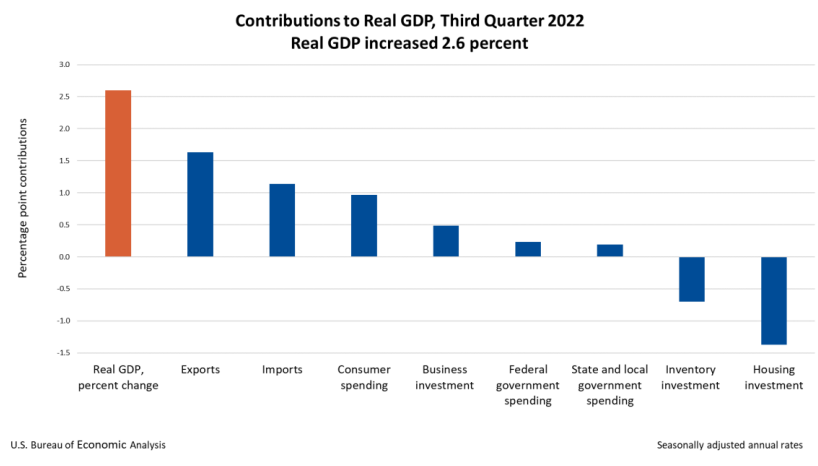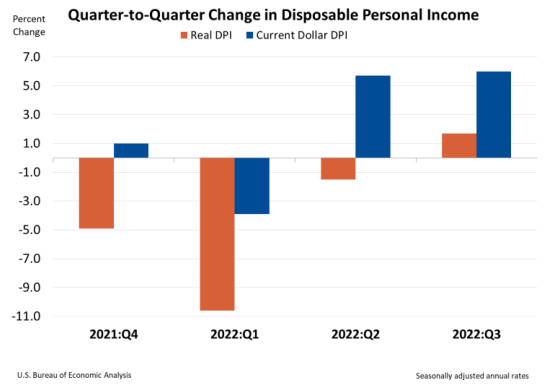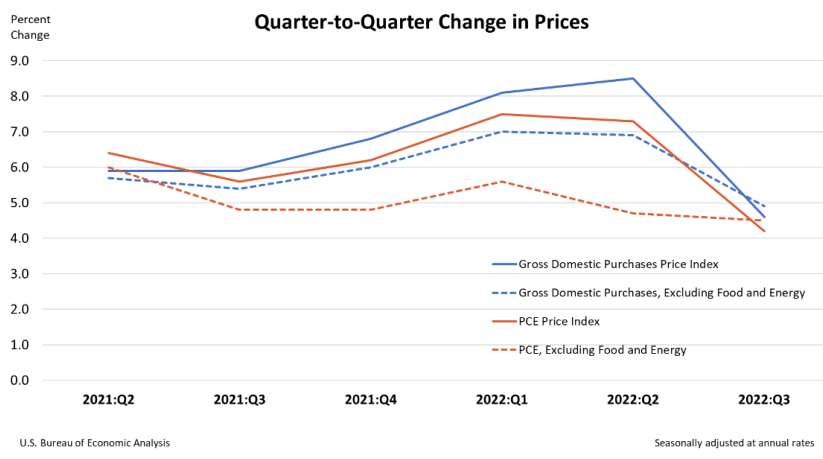Real gross domestic product (GDP) increased at an annual rate of 2.6 percent in the third quarter of 2022, in contrast to a decrease of 0.6 percent in the second quarter. The increase in the third quarter primarily reflected increases in exports and consumer spending that were partly offset by a decrease in housing investment.
The upturn in the third quarter, compared to the second quarter, primarily reflected a smaller decrease in private inventory investment, an upturn in government spending, and an acceleration in nonresidential fixed investment that were partly offset by a larger decrease in residential fixed investment and a deceleration in consumer spending. Imports turned down. For more details, including source data, refer to the Technical Note.
GDP highlights
The third-quarter increase in real GDP reflected increases in exports, consumer spending, business investment, and government spending that were partly offset by decreases in housing investment and inventory investment. Imports, which are a subtraction in the calculation of GDP, decreased.
- The increase in exports reflected both goods (led by industrial supplies and materials as well as nonautomotive capital goods) and services (led by “other” business services and travel).
- The increase in consumer spending reflected an increase in services (led by health care and "other" services) that was partly offset by a decrease in goods (led by motor vehicles and parts as well as food and beverages).
- The increase in business investment reflected increases in equipment and intellectual property products that were partly offset by a decrease in structures.
- The increase in government spending reflected increases in federal (led by defense spending) as well as state and local.
- The decrease in housing investment was led by new single-family housing units and brokers’ commissions.
- The decrease in private inventory investment was led by retail trade (mainly “other” retailers).
- The decrease in imports reflected a decrease in goods (led by consumer goods) that was partly offset by an increase in services (led by travel).
Personal income and saving
Real disposable personal income (DPI)—personal income adjusted for taxes and inflation—increased 1.7 percent in the third quarter after decreasing 1.5 percent in the second quarter.
Current-dollar DPI increased 6.0 percent in the third quarter, following an increase of 5.7 percent. The increase in current-dollar DPI for the third quarter primarily reflected increases in compensation and personal income receipts on assets.
Personal saving as a percentage of DPI was 3.3 percent in the third quarter, compared with 3.4 percent in the second quarter.
Prices
Gross domestic purchases prices, the prices of goods and services purchased by U.S. residents, increased 4.6 percent in the third quarter after increasing 8.5 percent in the second quarter. Excluding food and energy, prices increased 4.8 percent after increasing 6.9 percent.
Personal consumption expenditure (PCE) prices increased 4.2 percent in the third quarter after increasing 7.3 percent. Excluding food and energy, the PCE “core” price index increased 4.5 percent after increasing 4.7 percent.
For more information, read the full release.


